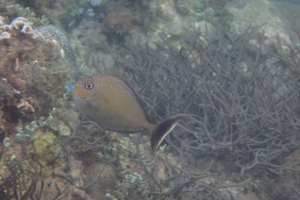Description
Also known as Bignose Unicorn, Bignose Unicorn Tang, Big-nosed Unicornfish, Blue-lipped Unicornfish, Doctorfish, Lancetfish, Scibbled Unicornfish, Thorntail, Thorntail Fish, Vlamingii Tang, Vlaming's Unicornfish, Zebra Unicornfish.
Found singly, pairs, or in small schools, sometimes congregating in large caves during the day, or over deep drop-offs, of lagoons and seaward reefs. Adults change all the time from pale to dark. These fish love to play in divers bubbles!!
They feed on zooplankton.
Juvenile's are a dingy green with blue lips and spots, later changing to a bluer fish with purple markings. However while the fish sleeps, or is frightened, it turns a muddy brown as camouflage.
Length - 60cm
Depth - 1-50m
Widespread Indo-Pacific
Surgeonfish have a blade like spine in the tail that points outwards when bent, unicorns have two hook-like plates along the tail, these are used for defence and are as sharp as a surgeons scalpel, hence the name "Surgeonfish".
Some species are venomous. Ref: https://www.fishbase.se/summary/Naso-vlamingii






































































0 comments